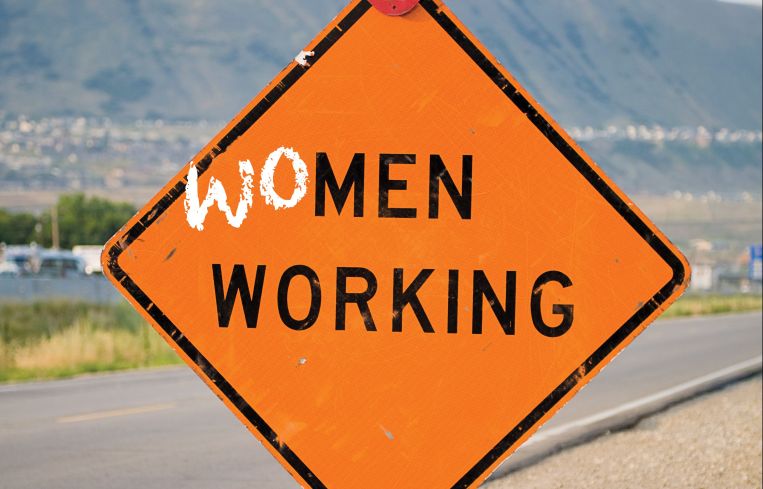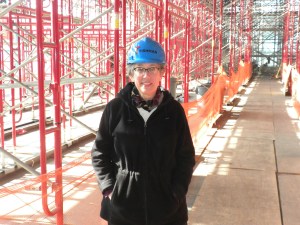One of the Biggest Industries in the Country—Construction—Still Has a Big Woman Problem
By Sara Pepitone February 1, 2017 11:23 am
reprints
You know the photograph: 11 construction workers smoking, eating and socializing across a beam hovering some 800 feet over Manhattan. It was 1932. The project was 30 Rockefeller Center (a.k.a., the RCA, GE and Comcast Building). The image illustrates our temerity, fearlessness and creativity, even in the middle of the Depression. Here we see our country and ourselves at our best, through what is undoubtedly a group of immigrants, not one of them a woman.
If that shoot was staged today, eight decades later, one of those workers would likely be a woman. Well, not quite one. Almost one.
According to U.S. Census Bureau data spanning 2011 to 2015, women represent 9.1 percent of the more than 9 million people employed by the construction industry in the U.S. About 2 percent of that 9 million live in New York City, and 8.4 percent of them are women.
According to the November 2016 New York State Department of Labor (DOL) statistics for the New York City region (companies based here), jobs in construction have been steady for the past year, with about 12,000 of them held by women. That includes everyone working for companies responsible for “construction of buildings,” specialty trade contractors (a.k.a. subcontractors) and a small percentage of heavy and civil engineering construction (not normally performed on buildings or building-related projects). And that’s 8.4 percent of the total.

Compare that percentage to women in the total New York City workforce: 48.9 percent.
To illustrate the significance of this disparity, consider this: In 2015, the New York State DOL’s division of research and statistics deemed the construction industry one of New York City’s 13 most significant (with education, finance, food and electronic product manufacturing, health care, professional services). Combined, the 13 industries account for about half the jobs in the Big Apple.
“The landscape of the world has changed, but the world of construction hasn’t,” said Barbara Kavovit, the chief executive officer of Evergreen Builders. “From technology to finance to infrastructure, everything revolves around an antiquated business.”
Kavovit has been part of the industry since the early 1990s when she started a home improvement company: carpet laying, tiling and every other service she could think of and fit on a business card. Project number one had Kavovit, who has a bachelor’s degree in finance and economics from SUNY Oswego, searching a penny-saver for subcontractors, hiring a handyman and a painter, and learning about inches of asphalt and how to pay herself. Later she learned to cut wood, put up drywall and other trade skills.
“I love ripping down walls, turning blueprints into actual things and being part of something that helps companies change the landscape.”
Kavovit advises women entering the industry to be professional, know their craft well and be detail oriented. “There is no room for error when you are building,” she said. And she’s optimistic. “Because there are more women in corporate America and more women architects, it can only get more advantageous for women in construction,” Kavovit said. “We don’t have to be stuck in a world that has not changed a lot.”
Nancy Czesak, the first vice president of construction project management at AECOM’s Tishman Construction, entered the world of construction in 1985. After obtaining a bachelor’s degree in architecture (she also has an master’s in construction management from New Jersey Institute of Technology) Czesak sent her resume to a P.O. Box in response to a blind newspaper ad at Tishman Construction. She was hired as chief scheduler, determining who should be doing what and when on a project. “We were still very formal then,” she recalled. “I didn’t even wear pants to work. I had to change out of my skirt in a bathroom every time I went into the field.”
Except the one time she didn’t, when she was not expecting a visit to a site with multiple basements. She laughs in memory of her younger self climbing down ladders in a skirt and heels while a superintendent shook his head in disbelief. Her advice to women in construction: Keep a sense of humor. Do not take things personally. Attitude is a big thing. “If you know it all, that won’t be well received. Embrace the knowledge the seasoned folks have and engage them. Get the superintendents on your side. They have an incredible wealth of knowledge.”
Now Czesak has more than two decades of onsite experience, including the renovation and upgrade of the Jacob K. Javits Convention Center. In the 1980s, she said, it was very intimidating to visit a job site. “Ninety-nine percent of men were pretty good about having a woman onsite. I think it’s the same now. It’s odd,”—those 1 percent of men who can’t abide it—“but it does come up. There’s just something. It’s not overt,” Czesak told Commercial Observer.
Like her peers at every level of ranking, Czesak noted communication directed away from her, toward other men in a group, as an example. “It’s less and less but if there’s a guy around the assumption is he knows best,” she said.
When we began research for this piece we figured everyone would have a tale of egregious sexism. Quite a few do. What we found more of, however, was the experience of a never-ending series of small offenses.
“Like when a subcontractor assumes you don’t know installation details or a group of owners assumes you are someone’s assistant, not the manager that is going to run the meeting you just walked into,” said Sarah Guenther, a construction project manager with Legacy Builders| Developers Corp. “At the end of the day, though, there is a large amount of satisfaction when you see them start to realize that you know exactly what you’re talking about.”
Guenther said there were few women in leadership roles when she entered the industry in 2013, after graduating with a bachelor’s in psychology from The New School. “For the most part women were, and still are, the secretaries and assistant project managers in this industry.”
Now, she said, there are more women to reach out to and learn from. And, perhaps more importantly, the industry is becoming less about resume and more about competence. “There is an ‘old boy’ model of construction that is dwindling and being replaced with a more tech-savvy, smarter crop of construction professionals,” she said.
In 1978, according to Nontraditional Employment for Women (NEW), a New York City-based nonprofit organization that prepares and places women in skilled, unionized construction, utility and maintenance trade roles, less than 2 percent of construction workers were women.
Today, NEW said, women make up an average of 10 percent of apprenticeship programs in New York City. That’s paid, on-the-job training. NEW prepares 400 women annually for apprenticeships, teaching safety regulations (graduates hold Occupational Safety and Health Administration 10 certificates, for 10 hours of safety training), math, manual dexterity and how to use trade tools. The organization also has graduates speak to students about their chosen trade, and what it’s like to be a woman in it.
“Their personal experiences give students a real-world view of being a woman on a job site,” according to a spokesperson for NEW, which also offers workshops on sexual harassment, communications skills and self-esteem.
In 2016, NEW placed 265 women in jobs as carpenters, concrete workers, electricians, facility managers, ironworkers, laborers, operating engineers, plumbers and sheet metal and utility workers. “The 265 placements in 2016 includes both permanent and interim positions,” NEW told CO, adding that the organization has placed “a total of 1,500 women over the last 10 years” in those positions.
“I wake up every morning at five,” graduate Rochelle James, an electrician with Local Union 3, International Brotherhood of Electrical Workers, told CO in an email through a spokesperson for the union. “I put on clothes that will get covered in dirt. I break my nails. I ache at the end of the day. And, you know what? I love it.”

Love is significant, but so are logistics. The first step of training determines whether or not construction is right for a job seeker. Information sessions begin with straightforward questions like: Are you willing and able to perform physical labor for eight hours a day? Do you need help finding early morning child care?
“You have to have that ‘something’ to work on a barge in the East River in the middle of winter,” graduate Latoya Bolen, a journeywoman in NYC District of Carpenters, Dockbuilders/Timbermen Local Union 1556, told CO in an email through a spokesperson.
“I was accepted into the apprenticeship and started work on my first job at the Willis Avenue Bridge,” Bolen told the NEW Equity Leadership Awards luncheon in 2015. “I was one of two female dock builders on the job which is unheard of. Normally, I am the old woman and I didn’t have any family members in the trades. I was like an orphan going in and was unsure whether I’d be accepted and trained.”
The road that Bolen proceeded to trek was treacherous but ultimately extremely fulfilling.
“In a crew of 30 to 40 brothers, I realized quickly that I had to be a chameleon and adapt to my surroundings,” Bolen said at the luncheon from the stage. “If I stood around waiting to talk to someone like me I’d be waiting a long time and isolate myself even more. The work is heavy…But train me they did. When I would try and be very accurate with my measurements and cutting they would say, ‘Latoya, we’re not building furniture, you’re a dock builder.’ And they made me one.”
Thirty years ago, when MEPS (Mechanical Electrical Plumbing Structural) Superintendent Emma Hamza was 36 years old and beginning a career in construction, she said it was tougher for women. And asking questions, even for clarity, was the quickest way to lose male respect. But she was never uncomfortable, though she acknowledges many women still are intimidated by male-dominated job sites—which is to say, every job site in construction. “I try to keep my composure and minimize cursing,” Hamza said. “You grow a tough skin.”
Hamza supervises the mechanical, electrical, plumbing and fire protection trades on projects like renovation of the American Wing at the Metropolitan Museum of Art and building the new FAA Air Traffic Control Tower at Newark Liberty International Airport. As a superintendent, Hamza said, you’re doing quality control. “They are the professionals. I only approach it if there’s a problem, like improper installation. It’s kind of tough for some to take direction from a female, but the younger generation is better. They see I am the authority.”
She has worked with Hunter Roberts Construction Group, where 21.5 percent of the staff is women, since 2008, but she never knew of another female superintendent until last week. “We were so happy to see one another,” she said. The two, who have different areas of expertise, plan to rely on each other for related advice.
Networking is key to success and survival for women in the industry. Organizations like Professional Women in Construction can offer guidance, support and yes, new work.
After getting fired from a job in finance while in recovery from an ovarian surgery, Deborah Bradley decided to take her Certified Public Accountant license and Master of Business Administration from Columbia University and start her own business. One day a handyman doing work in her apartment asked for help (he was owed back wages from a bankrupt contractor). Bradley turned her focus to construction and quickly reached out to a potential client in the neighborhood where she lived: her alma mater, Columbia University. She learned to read plans, make estimates and project manage as a contractor in the New York City School Construction Authority mentor program.
She was also learning to be a mom. “Pregnant Contractor” was the nickname other contractors used without shame. “You have to have a lot of thick skin as a woman in construction, especially in those days,” Bradley said of the early 1990s, recalling the number of projects she bid on that went to companies owned by men, just for that reason.

But she enjoyed the work so she devoted herself to it, deliberately seeking clients near home so she could breastfeed. “I got out, did meet-and-greets, joined organizations. People thought I was a big contractor because they saw me all the time,” Bradley said and laughed. Young people wanting to get into the industry take note: Now that she is a big contractor she sees that strategy as part of her success.
Then she discovered her handyman-turned-partner was embezzling. She started over and turned her attention to the public sector. There, “rip-and-read procurements offered a fair shake,” she recollected. That was 1994, and she’s never looked back (not even when a public official continually asked her loyal workers, “Who’s her daddy?” whenever she was offsite).
Today, the president of the Women Builders Council, Bradley and the treasurer and board member of Women Construction Owners & Executives is committed to mentoring women entering the construction industry. Her most important advice: Figure out where you fit (in client relationships and beyond). And always finish your projects.



